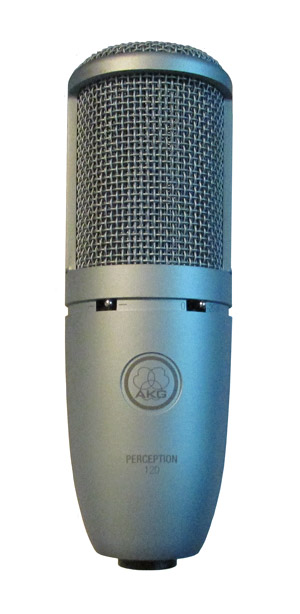MICROPHONES
North Suburban HAMMOND ORGAN Service
The condenser microphone is the next and final one that we will look at, and I'll actually devote a little more detail to it as this is the type that we use at the NSHOS when we use microphones, and also because in general these are the best microphones available when it comes to flawlessly converting soundwaves to audio signals accurately.
Figure 6. An AKG condenser microphone.

The word condenser was, in the early days of electronics, used to describe a capacitor. I have already created a fairly detailed description of elementary capacitors and how a capacitor can be used to generate an audio signal in our article on the Wurlitzer Electrostatic Organ, and if you click on that, it will take you right to the section of the Wurlitzer article that deals with capacitors as audio signal generators.
For whatever semantic reason, the term condenser has stuck when it comes to describing what is technically the electrostatic microphone, and I'll continue to use the term here because of this widely accepted convention.
In the condenser microphone, the diaphragm is often a very thin film of plastic which has been gold-plated on one side. It is imperative for accurate response that the diaphragm of a microphone should ideally have no weight or mass at all. While such an entity is a physical impossibility, the condenser microphone diaphragms today approach that ideal. Because they have so little mass and weight, they can respond to soundwaves extremely accurately. Among the most important microphone characteristics, as we'll see soon when we look at graphical representations of their responses, condenser microphones have both a very wide frequency range, and a very even or flat frequency response throughout most of the audio frequency band [20 Hz. to 20 kHz.]
On the next page we will look inside this microphone and see what makes it go, but first we should continue with the general discussion. The microphone element or capsule, consists of a very low mass diaphragm, gold-plated on one side. A very short distance behind the diaphragm is the backing plate. Wires are attached both to the backing plate and also to the support structure of the diaphragm. This is necessary to apply the polarizing voltage and also to extract the audio signal which the capsule, which is really a tiny capacitor with one fixed and one movable plate, develops.
The signal develops across a load resistor, having a very high resistance, up in the megohm range. [1 megohm = 1,000,000 Ω]. There are two very important considerations regarding this signal. First, the signal is an extremely small signal, and second, the impedance (which we'll get into soon) is very high. Transmitting really low level signals is difficult; transmitting low level signals in a very high impedance circuit is even more difficult. All kinds of things come by to bite us where the sun usually doesn't shine when we try to do this. So at this point you will probably ask yourself, "self, if the signal is that low, and the impedance is so high, why would I even bother with a condenser mic in the first place when I face such serious limitations?"
Considering the very low amplitude of the condenser microphone's output signal and the high impedance, realistically, you can only transmit this signal for a distance of a few inches from the mic capsule before huge losses and serious signal degradation set in. So how is it possible for a condenser mic to be at all useful in standard microphone applications?
Page 5. Previous page | Next page